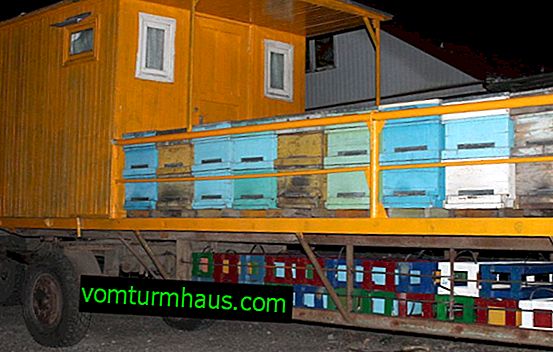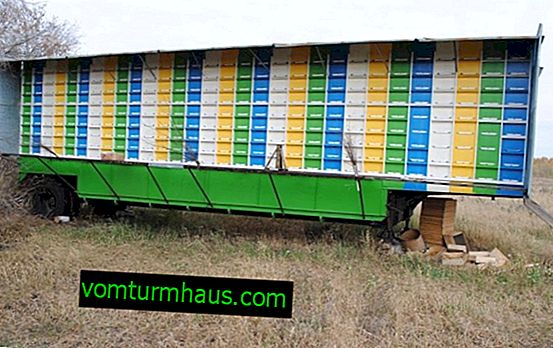Trailers for transporting bees: what is needed and how to use it
Transportation of bee houses is an integral part of apiary maintenance. Hives are usually transported using a special trailer. How to make such a trailer and carry out the movement of hives - read on.
Important! You can not transport bees in the summer heat. During transportation, the bees are always excited, which increases the level of heat and humidity inside the house, and insects can die from overheating.
Why do you need to transport bees?
Every beekeeper knows that changing the location of the hives is one of the main conditions for the normal functioning and development of bee colonies. In addition, changes in habitat affect the quality of honey. Often, honey fields are located away from the apiary, and it is difficult for bees to travel a long way.

Bees experience less discomfort, because the temperature inside the house will be reduced. You need to move the apiary in the direction of the region where as many different honey plants grow as possible - the more flowering crops are located near the hives, the more collection the beekeeper will receive.
Important! It is necessary to observe a minimum distance of transportation of beehives of 4 km, otherwise some bees will return to their original place, and this can destroy the colony.
Pros and cons of mobile beekeeping
- Advantages of mobile beekeeping:
- population increase;
- improving the quality of honey products;
- improving the quality of pollination of crops.
The main disadvantage is the high mortality rate of insects during improper transportation.
Types of trailers for transporting bee hives
Transportation of beehives is very important for the beekeeping process, but non-observance of the rules during transportation can harm insects, so when you start wandering, you need to be well prepared.

There are such types of trailers designed for transporting beehives:
- car trailer;
- platform;
- pavilion.
Car trailer
In the back of a truck, hives are transported over long distances. Small apiaries can be transported in a car trailer.
Did you know? One bee colony totals 50 thousand individuals and weighs 5 kg.
In order not to harm the bees when moving, you must follow these recommendations:
- To reduce the impact of vibrations on insects when moving the machine, you need to cover the bottom of the platform with straw.
- Honeycombs should be placed parallel to the sides of the machine.
- Keep a 10 cm spacing between the hives.
- The apiary should be loaded and unloaded with extreme caution.
- When driving, it is recommended to withstand speeds of not more than 50 km / h.
- Firmly fix the frames so that they are motionless when moving.

Platform
The platform is a miniature apiary on wheels with a capacity of 50 hives. It can be uniaxial or biaxial.
- Advantages of using the platform:
- may be multi-tiered;
- it is possible to install a cover protecting the hives from rain and sun;
- the vertical arrangement of bee houses makes it possible to simplify the process of extracting honeycombs.

Pavilion
The transportation pavilion not only serves as a means of moving bee houses, but also is their permanent storage place. Usually pavilions are divided into working and household parts. The pavilion with a volume of 45 m³ can accommodate 30 houses located in 3 tiers of 5 houses on each side of the platform.
There are 3 types of pavilions:
- stationary, which do not have wheels to move;

- mobile;

- cassette - have cells for bee houses.

How to make a do-it-yourself trailer for transporting bees
For the independent manufacture of the trailer, it is necessary to prepare a drawing of the platform. For the basis of the product you need to take a cart, an old trailer from OZPT-Sarmat will be an excellent option.
For the manufacture of the platform, the following materials and tools are required:
- profile pipe 25 × 50 mm - 12 m;
- profile pipe 20 × 40 mm - 24 m;
- corners 4 × 180 mm — 2 pcs .;
- corners 4 × 60 mm — 10 pcs.;
- iron loops - 10 pcs.;
- round pipe 20 × 240 mm - 3 pcs.;
- plastic panels 10 × 180 cm - 20 pcs.;
- steel sheet, the size of which is calculated according to the drawing, depending on the dimensions of the product;
- bearings - 8 pcs.;
- plywood 16 mm thick for forming the bottom in the trailer;
- welding machine.
The production of the platform must begin with lengthening the frame by 1 m with a profile pipe and installing the chassis on the trailer.
Did you know? A bee is able to recognize the smell of a flower at a distance of 1 km.
Step-by-step assembly of the platform:
- From a profile pipe 25 × 50 mm, make a frame 2.4 × 1.8 m in size. To ensure the strength of the structure, weld pipes of a smaller section (20 × 40 mm) transversely every 0.5 m.
- Using a welding machine, weld the resulting structure to the wagon. Mark the resulting platform into 3 parts.
- To position the bee houses at the bottom of the platform, design retractable skids.
- To make the frame for the slide from the profile pipe 25 × 50 mm.
- Using 10 corners 4 × 60 cm, which are attached to the bottom of the structure, distribute places for hives, 5 on each side.
- On both sides of the sides, install 5 iron loops to tighten the hives.
- Line the bottom of the frame with a sheet of steel.
- Spread the bearings around the frame to ensure the mobility of the slide.
- Cover the bottom of the platform with plywood on top of the steel sheet.
- At the corners of the frame, weld racks from a profile pipe 20 × 40 mm with a height of 1.55 m.
- At the location of the slide from each side of the platform, install 2 racks from a profile pipe 20 × 40 mm 1.65 m high.
- The drawbar of the obtained structure should be strengthened with a round pipe measuring 20 × 240 cm, passing it to the middle of the platform.
- At a slope, weld 2 corners 4 × 180 cm in size to the drawbar.
- From the remaining corners to build a canopy, cover it with plastic panels.

Features of the use of trailers
Automobile trailers made by oneself should be used only for their intended purpose, observing the scale of the product, which should not exceed the maximum permissible traffic limits. It is necessary to inspect the trailer as often as possible, which consists in aligning the curved parts damaged due to impacts when moving along bumps, and tighten the fasteners.
When towing bee colonies, it is unacceptable to exceed speeds - this will lead to a wagging movement of the wagon. When moving, it is impossible to sharply slow down, as well as to unevenly distribute the transported cargo, otherwise the wagon will tip over.
You will be interested to learn how to make a pavilion for bees with your own hands.
Useful tips for beekeepers
Tips from experienced beekeepers:
- Nomad alone is inconvenient, so it is better to join a group.
- Before transportation, you must select a location for the apiary. Sometimes transportation can be carried out at 500 km from the house, but do not be afraid of such great distances - after all, the costs will be paid off with high-quality honey collection.
- To choose the right place for an apiary, you need to contact the district livestock specialist, as well as obtain permission to place an apiary from the owners of the farm. Installing an apiary in the forest will require permission from the forestry.
- After the honey collection, the bees become stronger, their anxiety increases. The honeycomb contains a large amount of unripened honey, which leads to an increase in humidity in the middle of the nest and the risk of cell breakage. To prevent a tragedy, when moving, it is necessary to remove the frames filled with honey and insert empty ones instead.
- When transporting in the spring, when the bee colony is not yet strong and the nest contains a small amount of honey, it is necessary to lay a blank canvas on top of the frames, clamp it with planks and hammer with nails, which will provide protection from the cold.
- When transporting in summer and autumn, loose burlap should be packed on the sides of the hives. If the house does not contain boards, empty frames must be put on it, onto which to nail the burlap. Matter serves as ventilation and does not allow much light to pass, thereby preventing the temperature from rising inside the nest.







